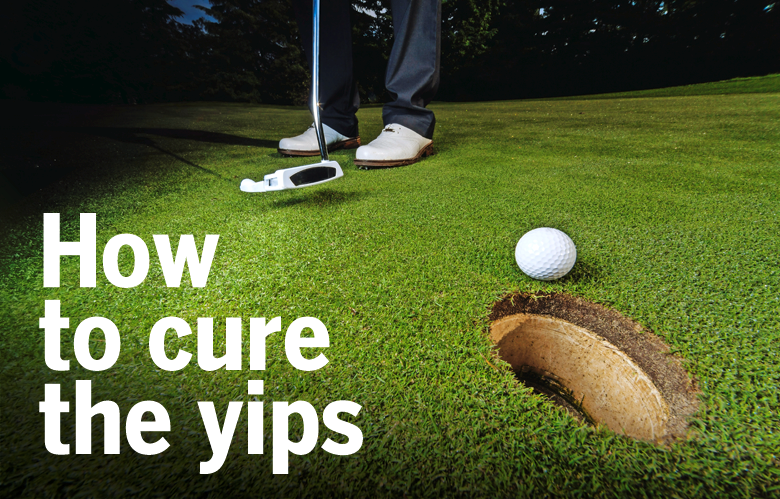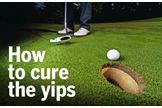How to cure the yips
Last updated:
|
It’s an affliction that has ended careers, destroyed hobbies and driven normally sane people to moments of madness and exasperation – welcome to the world of the dreaded yips. For years people have searched for solutions and cures to an anxiety breakdown that sees chips and pitches thinned or duffed and one-foot putts failing to even hit the hole. The record books are littered with victims (Langer, Hogan, Vardon, Alliss) and you won’t find a golf club in the country that doesn’t have its quota of members who have seen their handicaps soar as their nerves get raw. So, what are the yips and what are the best ways to deal with them? We asked Gordon Morrison, who lectures in sport psychology and motor behaviour at the University of Sunderland, to try to explain. “Scientists are not all in agreement about the main causes,” he told us. “Some suggest a neurological problem, a focal dystonia (like writer’s cramp), possibly caused by over-use of fine movements. Others come at it from the psychological angle, suggesting that the pattern of thinking is responsible. “In this instance, personality types may be relevant, with perfectionists being more susceptible. For example, a player may be investing too much thought into his movements and the process of executing the swing. This causes ‘choking’ as the golfer focuses on irrelevant issues during the shot (like what they don’t want to happen). “Despite considerable research, no clear reason exists for why they start, and often it is very sudden. Many sufferers will remember the exact time and place they first occur. “The treatments that have evolved from the neurological diagnosis include botox injections in the affected limb, sensory ‘tricks’ like a change of grip, muscle relaxants and acupuncture. Psychologically, the yips have been treated by improved concentration, (eg adherence to a pre-shot and in-shot step-by-step routine) and through the use of solution focused imagery (the player learns to see themselves without the problem and describes in detail what they are doing).” If you suffer from the yips, help with the research by completing a short survey, before reading our top tips for beating the yips. |
|
 |
|
 |
|
|
Research has shown that the yips occurs in one hand or the other, but, crucially, not both. In this example here, with the putter, take the club in the left and then the right hand and get a feeling for which one has the twitch problem. Once you’ve deduced where the demon is lurking, then grip the club tighter with the good hand and much more loosely with the bad one. Taking this step will minimise the adverse effect of the yip. |
|
 |
|
 |
|
|
Even when you have the yips you may be able to make the correct moves through the stroke when in slow motion. This can be a good way to conquer the problem. Start by practising a swing so slowly that the twitching is not present. You may want to build up the speed if that feels comfortable or continue to rehearse the motion very slowly until it is ingrained with no damaging side effects. If you have the yips in the long game, try thinking about chipping the ball forward in a straight line off the front of the tee. If it’s the full swing that causes the yip, convince yourself that you just want to bunt the ball forwards, but then hit through much harder, so that the ‘chip’ becomes a full shot. |
|
 |
 |
 |
 |
|
Tricks to take your mind off the task at hand are always good when trying to defeat the yips. In this example, we have a leaf that is quite close to the ball. You should continue your usual pre-shot routine and play your shot in normal time, but just as you’ve settled ready to go, ask yourself what sort of leaf that is? You’ll be surprised how your touch and feel for the shot is controlled by your subconscious. |
Another way to distract your thoughts away from the pressures of the shot, be that a long shot, chip or putt, is to give your brain tricky tasks. Starting at 100, try counting backwards in groups of three. Say it in your head, “97, 94, 91…” and you’ll be able to execute your swing without demons getting in the way. You can’t think about two things at once. |
 |
|
 |
|
|
One of the triggers to yipping is the ball itself. It might only be 1.68 inches in diameter and covered in rather cute dimples, but to the afflicted, it can fill the conscious brain with overwhelming feelings of dread and anxiety. Experiments have shown that one of the best ways to overcome this is to focus, not on the ball, but the landing spot when you’re chipping. If it’s a putt we’re talking about, then train your eyes either on the apex of a breaking putt or, for shorter ones, on the hole itself. This might seem radical, but it does work. I was in the gallery at the Wales Open this year and watched as an English Tour professional chipped cack-handed and looking at the landing point every time he was faced with a chip shot. His short game that day was excellent. |
|

